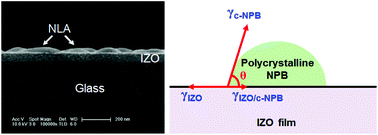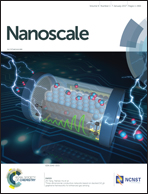Crystallization-assisted nano-lens array fabrication for highly efficient and color stable organic light emitting diodes†
Abstract
To date, all deposition equipment has been developed to produce planar films. Thus lens arrays with a lens diameter of <1 mm have been manufactured by combining deposition with other technologies, such as masks, surface treatment, molding etc. Furthermore, a nano-lens array (NLA) with a sufficiently small lens diameter (<1 μm) is necessary to avoid image quality degradation in high resolution displays. In this study, an organic NLA made using a conventional deposition technique – without combining with other techniques – is reported. Very interestingly, grazing-incidence small-angle X-ray scattering (GI-SAXS) experiments indicate that the NLA is formed by the crystallization of organic molecules and the resulting increase in surface tension. The lens diameter can be tuned for use with any kind of light by controlling the process parameters. As an example of their potential applications, we use NLAs as a light extraction film for organic light emitting diodes (OLEDs). The NLA is integrated by directly depositing it on the top electrode of a collection of OLEDs. This is a dry process, meaning that it is fully compatible with the current OLED production process. Devices with NLAs exhibited a light extraction efficiency 1.5 times higher than devices without, which corresponds well with simulation results. The simulations show that this high efficiency is due to the reduction of the guided modes by scattering at the NLA. The NLAs also reduce image blurring, indicating that they increase color stability.


 Please wait while we load your content...
Please wait while we load your content...